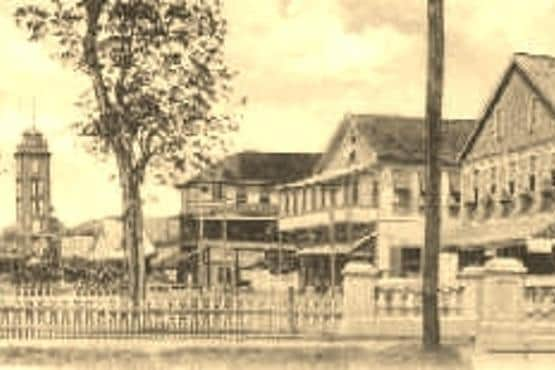Morpathia: The latest article about the Morpeth Dispensary
and live on Freeview channel 276
A meeting of the Committee and a special meeting of the Governors took place on the 14th when the Governors, following the Committee’s recommendation – by this time they were virtually the same people – elected Mr Arthur Rannie of Aberdeen to commence on October 2nd.
The Committee also requested a Mr Garry to send in an estimate for “the work thought necessary to be done to make the Dispensary habitable”.
Advertisement
Hide AdAdvertisement
Hide AdArthur Rannie was a Scots-Canadian from Chatham, Canada West (now Ontario). He was born in September 1861, the son of the Rev. John Rannie and his wife, and was the eldest of ten children.


He had recently received the degrees of Bachelor of Medicine and Master in Surgery from the University of Aberdeen.
He presented the medical report for 1882: “During the year 1882, 675 patients were admitted to the benefits of the Institution. Of these, 33 died and 25 remained on the books at December 31st. The mortality was thus nearly 4.9 per cent of the total number of patients admitted.
“The fatal cases may be classified as follows – Phthisis, 4; Bronchitis, 5; Chronic Bronchitis and Emphysema, 1; Pneumonia, 1; Senile Decay, 5; Paraplegia, Hemiplegia, and Apoplexy, 4; Heart Disease, 3; Measles, 2; Hooping Cough, 2; Chronic Bright’s Disease, 1; Tabes Mesenterica, 1; Debility from Birth, 3; Convulsions, 1. …
Advertisement
Hide AdAdvertisement
Hide Ad“The following is a list of the more important illnesses attended:– Smallpox, 7; Measles, 28; Scarlet Fever, 6; Rotheln, 6; Hooping Cough, 30; Mumps, 6; Diarrhoea, Dysentery, and Enteritis, 31; Bronchitis, Asthma, Pleurisy, and Emphysema, 92; Pneumonia, 5; Erysipelas 5; Rheumatic Fever, 2; Diphtheria, 1; Dyspepsia and Debility, 78; Injuries, 17.


“The cases of Smallpox occurred in the early part of the year and all the patients recovered satisfactorily. Nearly all the cases of Measles and Hooping Cough occurred during the months of October and November. Of the 4 deaths resulting from these diseases, 3 were dependent on complications arising during the progress of the disease and 1 was due to Malignant Measles. The cases of Scarlet Fever were all of a mild type.”
Rotheln is German measles, from the German for red. In other respects, this report is much like all the previous ones.
Bronchitis and other chest diseases were rife, as were the childhood fevers and diseases of the stomach and bowels. The 78 cases of dyspepsia and debility is telling and is perhaps a measure of general unwellness. The deaths included 12 children under five years of age.
Advertisement
Hide AdAdvertisement
Hide AdAt the same annual meeting, W.E. Lawson, Esq., of Longhirst, was elected a Vice-President in the room of his father, deceased. He also became a Trustee, an important role since the Dispensary could not hold investments or property in its own name.
Dr Rannie only stayed for about four months and there is no record of him taking part in any social activities. He resigned on February 5, 1883, and the Committee resolved to accept his resignation provided he found a substitute for three months from May 31st, or until an appointment was made.
The usual period of notice was three months, i.e. to May 5th, but perhaps the Committee felt justified in making this demand because he was leaving after such a short time.
His new job was at the West Riding Asylum, Wakefield, but only three years later, in 1886, he was appointed to the Colonial Medical Service, British Guiana, where he was described as having been late pathologist and second medical officer at the West Riding Asylum.
Advertisement
Hide AdAdvertisement
Hide AdHis reason for going abroad was family. His father was John Rannie, M.A., of King’s College, Aberdeen, who was at one time schoolmaster at Coull in Aberdeenshire.
In 1857, he was ordained by the Presbytery of Kincardine O’Neill for service in Canada and in 1859 was the minister at Chatham, Ontario, where Arthur was born.
He was appointed to British Guiana in 1876, when Arthur would have been 15, and became minister of All Saints’ Church, New Amsterdam.
Arthur died of yellow fever at Demerara in January 1888. I have no record of him marrying. The Rev. John Rannie retired in 1904 and died at Moreton in Essex, where he presumably had family.
Advertisement
Hide AdAdvertisement
Hide AdGoing back to 1883, Arthur wasted no time in finding a substitute and before the end of the month another young doctor, William Pyle Ross, was appointed locum tenens for three months.
There was an outbreak of scarlet fever in March-April while he was in office. At the April meeting of the Local Board of Health, the MOH, Dr Clarkson, reported that: “Scarlet fever, which seems to have been hovering about the town for months past … began to show signs of increased activity in February, both as regards numbers and severity of type.
“About the beginning of March came the sudden transition of temperature from almost summer heat to winter cold, and with this change an alarming increase of the severity and fatality of this disease ... The disease has not been confined to any particular locality, but ... finding, from reference to the Dispensary books, that by far the greater number of ill had been attending the Borough Schools (where the average daily attendance is about 300 children), I recommended the town council to prolong the Easter holidays for one week – a recommendation which the following letter proves has been attended, so far, with the happiest results:–
“Morpeth Dispensary, April 9th, 1883
“Sir, – In reference to your request that I should observe what effect, if any, the closure of the public schools seemed to have on the prevailing epidemic of scarlet fever, I beg to state that in the week from the 2nd to 9th April, the disease has manifested itself in two houses previously unaffected.
Advertisement
Hide AdAdvertisement
Hide Ad“In each of these two cases, however (McLeish and Lumley), there is the clearest evidence of the importation of infection from houses where several children had suffered.
“The closure of the schools has, in my opinion, been a prompt and efficient check to an epidemic that was spreading with alarming rapidity.
“I am, Sir, Yours very sincerely, Wm. Pyle Ross, M.A., M.B., C.M.”
This is almost the last we hear of Dr Ross. He was a candidate for the permanent post, and was supported by four governors, but was beaten by another candidate who got six votes.
Advertisement
Hide AdAdvertisement
Hide AdHe graduated MB and CM from Aberdeen in August 1882; “William Pyle Ross, M.A. Aberdeen”. It would appear from this that he belonged to Aberdeen, but not so. He actually came from Banff.
Six years later he was living at Horwich in Lancashire, married with a young son. He died there in August 1897.
The Banffshire Journal reported his death: “Ross – At Duff House, Horwich, Lancashire, on 17th inst., William Pyle Ross ... age 41 years.
Duff House is the name of a stately home just outside the town of Banff.
Books by Roger Hawkins are available at Newgate News and the Old Herald Office in Morpeth, or from Amazon.